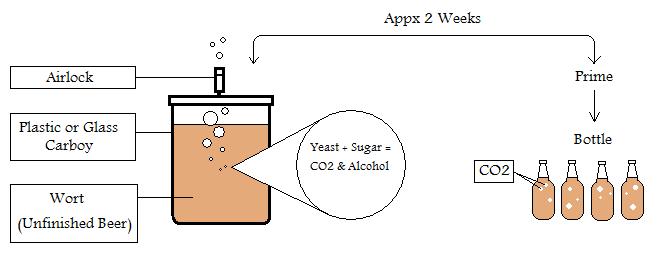There are two options for storing and carbonating your beer. This first option is bottling your beer, and the second option is kegging your beer. Most home brewing kits use plastic or glass bottles to naturally carbonate your beer, and I will be explaining that process in this article. If you keg your beer you would be force carbonating your brew using a CO2 Canister. I will be discussing bottling and natural carbonation in this article and kegging in a later article.
Here is a basic diagram of the bottling process in most Home Brewing Kits:
You will know when fermentation is complete when your stop seeing bubbles/activity in your airlock. This can be anywhere from 1 week to 3 weeks, because it depends heavily on the ingredients/recipe that you’re using for your beer.
At this point your wort has no carbonation, and if you were to bottle your wort without priming you would end up with flat beer. Priming is the process of adding a small amount of sugar (or dry malt extract) to the wort before sealing the wort in the bottles. There is just enough yeast left at this point to eat some of the sugar from priming and produce CO2 as a bi-product. Since the bottle is sealed, the CO2 is trapped in the bottle and gets absorbed into the beer. I like to use a small amount of dry malt extract to prime, because I find it gives the beer a nice thick head.
Your recipe or Home Brewing Kit should have instructions on what to prime with and how much to prime with. You want to follow these instructions carefully. Too much sugar could cause the bottle caps to pop off (too much pressure), and not enough could prevent your beer from carbonating at all.
Tips for bottling your beer:
- Make sure you sanitize all the equipment that comes in contact with the beer. Sanitize the bottling bucket, lines, bottles, and even the caps.
- If you’re using a bottling bucket, try to minimize the amount of oxygen you expose the wort to when transferring. The best way to do this is to use an auto siphon in your carboy and run the line to your bottling bucket.
- If priming with DME or sugar, you usually boil it first and then add it to your wort. I find that adding it to the bottom you your bottling bucket and then placing the line from your carboy in the bottling bucket at an angle gives me the best results. When you transfer the wort through your line it will “swirl” with the sugar / DME and make sure it mixes properly while exposing the wort to a minimum amount of oxygen.
- Don’t put the bottles in the fridge until it’s done carbonating. The fridge will prevent your beer from carbonating properly.
After you have your beer into the bottle, you need to wait for it to carbonate. My beer usually takes about 3 weeks to carbonate. Again, however, the amount of time to properly carbonate varies on the ingredients / recipe that you are using. It’s good to have a couple of “test” bottles. Try a test bottle every week until the beer is carbonated to your preference.
Good Luck Carbonating your beer –
Cheers!



